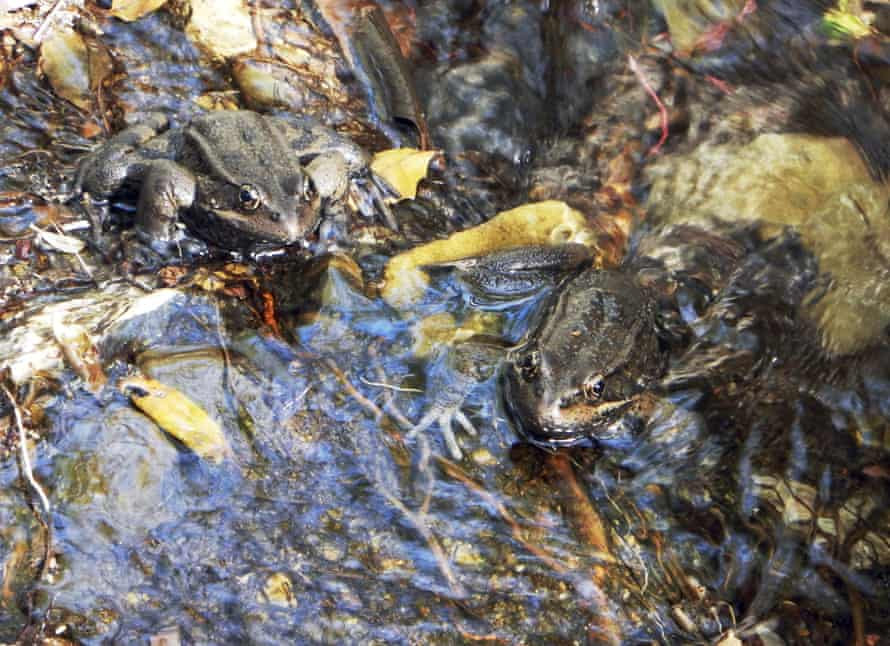One airport, 1,300 snakes: San Francisco helps to save endangered species
A parcel of land owned by the international airport is home to the largest population of the San Francisco garter snake

Last modified on Thu 19 Aug 2021 11.38 EDT
Across from the San Francisco international airport, and past the bustling highway that hugs it, lies what appears to be an empty lot. But the 180-acre, airport-owned parcel of land, which sits beyond the tarmac, tucked against residential homes, isn’t quite empty. It’s home to roughly 1,300 snakes.
With brightly painted bands of blue, orange-red and black that line their slender bodies, the garter snakes, which can grow up to 3ft long, are considered among the most beautiful in the world. They are also among the most threatened.
Endemic to the now highly urbanized San Francisco peninsula, the snakes have been pushed out by cities, agriculture and transportation systems, and there’s little space left for them to thrive. People have tried to pocket them for the pet trade, and the climate crisis has also put pressure on their prey and thinned the population further.
But officials at the Bay Area’s biggest airport and their on-staff wildlife biologist, Natalie Reeder, have worked for years to ensure the snakes have a haven – and now federal researchers have found that the habitat at the West-of-Bayshore property holds more of them than anywhere else. It also provides refuge to the endangered red-legged frog, which happens to be one of the snakes’ favorite snacks.
“Everything that happens there is designed to protect these species,” said San Francisco airport (SFO) spokesperson Doug Yakel. “For us, success would be that there is a stable thriving population, but to find out we had the largest population – it was really a pleasant surprise.”
The study, commissioned by the US Geological Survey and the US Fish & Wildlife Service, estimated the population of the snakes and determined that the habitat facilitated by the airport provided a local resurgence of a species that has been endangered for decades.
Their preferred place to live is near ponds, where they can spend their days hiding in vegetation or sunning on the banks. Hawks and herons are still their main predators, but in residential communities pets, especially off-leash dogs or outdoor cats, can also pose a problem.
But at Bayshore, they mostly have the land to themselves. The public is barred from the property, which has been converted into ideal conditions for snake and frog. Ponds dot the parcel and long grasses sway in the ocean breeze. “Our goal has been to ensure we are regulating the water flow,” Yakel said. “It looks undeveloped, but behind the scenes there’s a lot of work going on to preserve the vitality of that space, and preserving as natural a space as we possibly can.”
The success of the program is great news for the snakes, and for those who study and protect them. “It is really hopeful,” said Brian Halstead, a research wildlife biologist with the US Geological Survey. He said it shows how important managed lands can be for the snakes.
But even with the success of the program, Halstead said it’s unclear if the population will be sustainable there long-term, because they are so isolated from other populations. Climate crisis could also complicate efforts into the future. Already, for the snakes that dwell in isolated wetlands, human water-use has had an effect, and the landscape is drying.

One site where the snakes are studied is drier now than it was during 2014 and 2015, when the state was in its last record-breaking drought. Because the snakes rely on amphibians for food – especially young frogs that are just emerging from their tadpole state – when the water recedes, so do their chances.
“Climate change absolutely can impact them,” he said. “Anything we can do to slow climate change is going to help amphibians and the snakes that rely on them.”
Still, there’s more good news than bad when it comes to the San Francisco garter snake. Halstead thinks this could also have a positive effect on other animals that are struggling to survive.
“It is kind of neat that we can use this snake that is endangered as an ambassador for other snakes” he said. “Maybe we can reel people in and change their mind if we can show them how important it is not to lose these snakes, the frogs they eat, or any aspect of the ecosystems they depend on.”
Officials at SFO are proud to play a role, too.
Like most airports, Yakel said SFO is constantly looking to the future and reimagining how to enhance and change the experience for the tens of millions of passengers that pass through its terminals each year. But when it comes to Bayshore, it is exactly the opposite.
“As our airport continues to evolve, this is the one place that continues to stay the same,” Yakel said. “We want to continue to provide a good stable environment for these two endangered species. Hearing that they are thriving – that is the ultimate validation.”